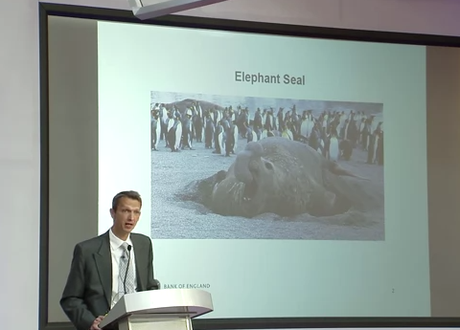
Anthony Haldane at INET Berlin.
Anthony Haldane, Executive Director for financial stability at the Bank of England, is one of the very best speakers on financial matters. Presenting ”Creating a Socially Useful Financial System” at the Institute for New Economic Thinking’s (INET) Paradigm Lost Conference in Berlin, 14 April 14, he was at his wise and witty best. Consider: “Return on capital is no longer investors’ priority. Return of capital is.”
Or: “While bank performance has fallen off a cliff, executive pay remains close to pre-crisis Himalayan heights.”
He even opened his presentation on a slide of a very large bull elephant seal: “Elephant seals have got too big for their beaches… Large males fight for the right to mate with a whole beach full of females. For elephant seals it is, quite literally, winner-takes-all. And the key to winning is simple – size.” He equated the mentality of the elephant seal with financial firms — and their obsessive desire to “keep up with the Goldmans”.
Trading at the speed of light
The heart of the speech was an eloquent review of the financial arms race that led to the credit crisis and continues to threaten markets today. A new and very interesting threat has emerged: Speed. “Over the past decade, trading in financial markets has undergone a technological revolution. The frontier of this revolution is defined by speed,” Haldane said. “A decade ago, trade execution times were measured in seconds. A few years ago, they were measured in milliseconds. Today, they are measured in microseconds. Tomorrow, it will be nano-seconds or pico-seconds.”
Trading speeds it seems played a key part in the so-called flash crash of May 6 2010 (or “The Crash of 2.45”), in which the Dow Jones plunged a 1000 points and then gained a 1000 – all in a few instants. High speed automated trading caused the entire US system to seize. Since then, Haldane sanguinely remarked, there have been “a large number of mini flash crashes in markets as varied as Japanese yen and cocoa futures.”
A new techno language
None of that made me feel any better; and it was notable through this section that Haldane’s terms changed. The languid references to “Darwinian tournaments”, and Alice in Wonderland’s “Red Queen Race” of the opening sequences of the speech, gave way to a very different techno-babble now – terms such as “quote stuffing”, “zero latency” and “message traffic congestion”. As the terms became more technical, more silicon, it became clear that human control over the trading, as over the language, is becoming less and less; rather the technology is moulding the language.
The great threat of a market crash engendered by computer trading is become more likely. And with that something more disturbing evolved from his remarks – the realisation that none of this market making is actually real any more – it can’t be when trades are happening in “pico-seconds”. It all takes place in a silicon space. Haldane actually recognised this in his words: “The mirage of liquidity proved just that. That evaporation appears to have played a key role in propagating stress during the flash crash.”
It is an extraordinary phrase, “the mirage of liquidity”, and it does exactly capture both the nature of automated markets and also why we are now in a new phase of finance.
For all the delightful references to peacocks, elephant seals, and Darwinian tournaments, we are no longer in a world driven by recognisable natural forces, such as the survival of the fittest. We are in a new world that does not recognize the blind watchmaker that does not obey Darwinian rules, that like, The Terminator, just keeps coming on, in trades “faster than the speed of light”. These are new areas where regulators do not hold sway.
Haldane’s speech opened with a Darwinian curiosity, the great survivor, the elephant seal alone on the beach. Somehow that seemed a telling image for a regulator. But his phrase the “mirage of liquidity” will haunt me more.
Haldane at INET in Berlin
To read a full text of Anthony Haldane’s speech, visit VoiceGig.

